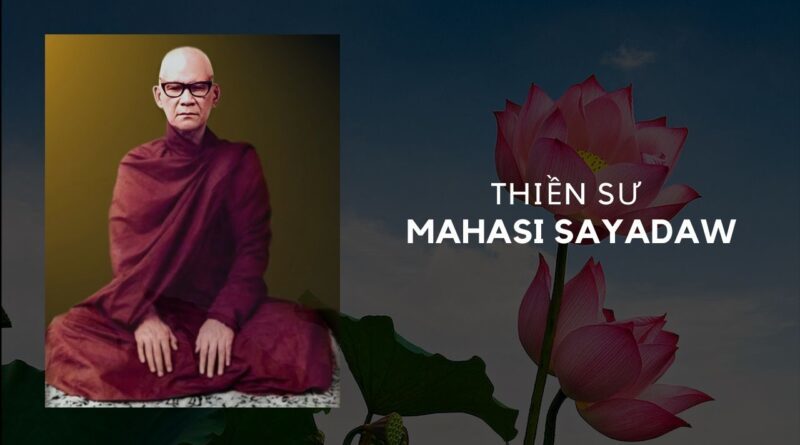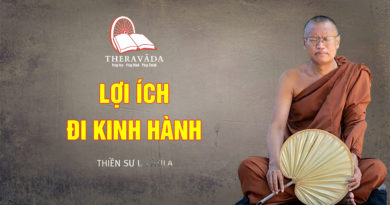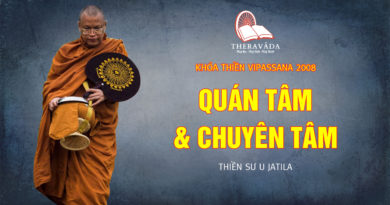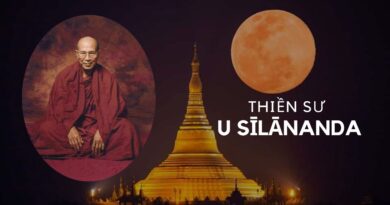How To Practice Samatha Meditation – By Mahasi Sayadaw
MAIN CONTENT
Samatha Meditation – THE METHOD IN BRIEF (BY MAHASI SAYADAW)
The samatha meditation comprises (40) sorts. They are as enumerated below:
1. Kasina (10)
2. Asubha (10)
3. Anussati (10)
4. Brahmavihara (4)
5. Aruppa (4)
6. Ahare Patikkulasanna (1)
7. Catu-dhatu-vavatthana (1)
THE TEN SORTS OF KASINA ARE:
1. Earth kasina (pathavikasinam)
2. Water kasina (apokasinam)
3. Fire kasina (tejokasinam)
4. Wind kasina (Vayokasinam)
5. Brownish or deep purplish blue kasina (nilakasinam)
6. Yellow kasina (pitakasinam)
7. Red kasina (lohitakasinam)
8. White kasina (odatakasinam)
9. Light kasina (alokakasinam)
10. Open air-space, sky kasina (akasakasinam)
THE TEN ASUBHAS ARE AS FOLLOWS:
1. Swollen or bloated corpse. (uddhumatakam)
2. A corpse brownish black or purplish blue with decay (vinilakam)
3. A festering or suppurated corpse (vipubbakam)
4. A corpse splattered half or fissured from decay. (vicchiddakam)
5. A corpse gnawed by animals such as wild dogs and foxes: (vikkhayittakam)
6. A corpse scattered in parts, hands, legs,
head and body being dispersed (vikkhitakam)
7. A corpse cut and thrown away in parts after killing. (hatavikkhittakam)
8. A bleeding corpse, i.e. with red blood oozing out. (lohitakam)
9. A corpse infested with and eaten by worms. (puluvakam)
10. Remains of a corpse in a heap of bones, i.e. skeleton. (atthikam)
THE TEN ANUSSATIS ARE:
1. Fixing the mind with attentiveness and reflecting repeatedly on the glorious virtues and attributes of Buddha. (Buddhanussati)
2. Reflecting with serious attentiveness repeatedly on the virtues and qualities of Buddha’s teachings and his doctrine. (Dhammanussati)
3. Fixing the mind strongly and repeatedly upon the rare attributes and sanctity of the Sanghas (Sanghanussati)
4. Reflecting seriously and repeatedly on the purification of one’s own morality or sila. (Silanussati)
5. Repeatedly reflecting on the mind’s purity in the noble act of one’s own dana, charitableness and liberality. (Caganussati)
6. Reflecting with serious and repeated attention on one’s own complete possession of the qualities of saddha. absolute faith, sila, morality, suta; knowledge, caga, liberality and panna, wisdom or knowledge just as the devas have, to enable one to be reborn in the World of devas. (Devatanussati)
7. Reflecting repeatedly with serious attentiveness on the supreme spiritual blissful state of Nirvana. (Upasamanussati)
8. Recollection of death or reflecting repeatedly on the inevitability of death. (Marananussati)
9. Reflecting earnestly and repeatedly on the impurity of the body which is composed of the detestable 32 constituents such as hair, body hair, nails, teeth, skin, etc. (Kayagata-sati)
10. Repeated reflection on the inhaled and exhaled breath. (Anapana-sati)
THE FOUR BRAHMAVIHARAS ARE:
1. Contemplation of loving kindness and goodwill or universal benevolence towards all sentient beings, praying “may all beings be happy.” (Metta)
2. Contemplation, of compassion, i.e. pity for and sympathy with those who are suffering praying in mind that “may all beings be free from misery and suffering.” (Karuna)
3. Contemplation of feeling rejoicing with others in their happiness or prosperity praying in mind that they “may continue to be happy and prosperous as at present with out diminution. (Mudita)
4. To remain indifferent with a feeling of equanimity to the state of condition of all beings, bearing an impartial attitude that things happen according to one’s own kamma that has been committed. (Upekkha)
THE FOUR ARUPPAS ARE:
1. Meditation or fixing the mind intently on the realm of infinity of space, sky pannata. (Akasanañcayatanam)
2. Meditation or fixing the mind intently on the realm of infinity of consciousness, pathama ruppavinnana. (Viññanañcayatanam)
3. Meditation or dwelling the mind intently on Nothingness, i.e. nothingness, that remains or exists from pathamaruppavinnana. (Akincannayatanam)
4. Meditation on the realm of Neither-perception nor Non-perception, i.e. semi-conscious state Jhana‘s perception Tatiya (third) ruppavinnana as “so calm, tranquil and gentle.” (Nevasañña-nasaññayatanam) Ahare patikulasañña: means the consciousness or perception of the impurity of material food derived from fixing the mind intently on the food and eatables as being detestable. Catudhatuvavatthanam: means contemplation on the existence or composition of the main four elements of dhatu in the body, namely, vayo (air or wind) and their differences in nature.
Ahare patikulasañña: means the consciousness or perception of the impurity of material food derived from fixing the mind intently on the food and eatables as being detestable.
Catudhatuvavatthanam: means contemplation on the existence or composition of the main four elements of dhatu in the body, namely, vayo (air or wind) and their differences in nature.
KASINA
A person who, of the forty sorts of samatha meditation, chooses the pathavi kasina as his subject of contemplation, should fix his eyes upon a spot of earth on the ground or a circle of earthdevice and contemplate mentally noting ‘pathavi, pathavi,’ or ‘earth, earth, earth.’ After repeated contemplation for a considerable time, the vivid image or nimitta of the earth-device will appear in the mind when the eyes are closed as clearly as when they are open.
This appearance of mental image is called “Uggaha, nimitta” (acquired image). If this “nimitta” becomes fixed and steady in the mind, he can go to any place and take up a posture of either sitting, walking, standing or lying. He should then continue to contemplate on the “Uggahanimitta” by saying mentally ‘pathavi, pathavi,’ or ‘earth, earth.’ While thus contemplating, it may happen that the mind does not remain fixed on its object and is likely to wander to other objects in the following manner.
1. The mind may think of desirable or agreeable objects according to its own inclination. This is called “Kamacchanda. nivarana” (sensuous lust).
2. The mind may also dwell on thoughts of despair and anger. This is called “Vyapadanivarana” (ill-will).
3. Slackness in contemplation may take place and the mind becomes dull and foggy. This is “Thina-middha-nivarana” (sloth and torpor).
4. The mind may become unstable and fleeting or restless, and then recollecting the past misdeeds in speech and bodily action, is likely to become worried. These are known as “Uddhaccakukkucca-nivarana” (restlessness and worry).
5. Thoughts may arise ‘whether the contemplation which is being undertaken is a right method, or whether it is capable of bringing beneficial results, or whether there is any chance to achieve any good result’s. This is “Vicikiccha-nivarana” (sceptical doubt).
When these five “Nivaranas” (Hindrances) appear, they should be discarded and rejected as they occur, and the mind should be immediately brought back to the original object of “Uggahanimitta” letting it dwell constantly on it, noting mentally as ‘pathavi, pathavi.’ If the kasina object of “Uggaha-nimitta” disappears from the mind, one should go back to the place where the earth-device is kept and contemplate again: ‘pathavi, pathavi’ by fixing the eyes on the device till “Uggahanimitta” is formed again in the mind’s eye.
Thereafter, one should return to the desired place and proceed with the contemplation as before in any posture of sitting, standing, lying and walking. Carrying on thus the contemplation of the object of “Uggaha-nimitta” repeatedly for a long time, the object assumes a very brilliant and crystalline appearance quite unlike that of the original. This is called “Patibhaga-nimitta” (counterpart-image). At the time the mind is free from all ‘Nivaranas.’ It dwells fixedly on the “patibhaga-nimitta.” This state of mind is known as “Upacarasamadhi” (proximate concentration). Now, by continually fixing the mind with this “Upacarasamadhi” on the ‘Patibhaga- nimitta,’ the mind reaches a state as if it were alive and sinks consciously into the object and remains fixed in it. This state of fixedness and stability of mind is known as “Appana-samadhi” (ecstatic concentration).
The Appana-samadhi is of four kinds, viz:
(a) the first Jhana
(b) the second Jhana
(c) the third Jhana
(d) the fourth Jhana
(a) In the first Jhana five distinct constituents are present; they are:
(1) Vitakka (initial reflection)
(2) Vicara (sustained investigation)
(3) Piti (rapture or ecstasy)
(4) Sukha (happiness or delight)
(5) Ekaggata (Tranquility of mind on one object with one pointedness.)
(b) One who has already attained the stage of first Jhana, seeing unsatisfactoriness in the first two constituents of ‘Vitakka’ and ‘Vicara’ again proceeds with the contemplation to overcome them and succeeds in attaining the stage of second Jhana where the three distinct constituents of ‘Piti,’ ‘Sukha’ and ‘Ekaggata’ are obvious.
(c) Again seeing unsatisfactoriness ‘in Piti,’ if he proceeds with the contemplation to overcome it and divests himself of ecstasy, he will attain the third Jhana which is a state of tranquil serenity and where the two distinct constituents of ‘Sukha’ and ‘Ekaggata,’ remains obvious.
(d) Again seeing unsatisfactoriness in ‘Sukha’ he proceeds with the contemplation to overcome it. By doing so, he attains the stage of fourth Jhana in which the mind exalted and purified is indifferent to all emotions alike of pleasure and of pain. At this stage the two constituents of ‘Upekkha’-(equanimity) and ‘Ekaggata’ become manifested.
This is, in brief, the description of the manner of contemplation of the “Pathavi-kasina” and the development of the stages of four Jhanas. The same applies to the remaining kasinas.
ASUBHA
In the case of a person who wishes to practise ‘Asubha’ meditation objects, he should fix his eyes on a bloated corpse, or a livid corpse, etc., and contemplate by saying mentally ‘bloated corpse, bloated corpse,’ livid corpse, livid corpse, etc. This contemplation is similar to that of ‘Pathavikasina,’ the fundamental difference being that the contemplation of these ‘Asubha’ subjects will lead to the stage of First jhana.
ANUSSATI
Amongst the ten Anussatis, the contemplation of the impure 32 parts of the body (kayagatasati- kamma tthana) will also lead to the stage of First jhana. The eight reflections (Anussati) consisting of the subjects from “Buddhanussati” to “Marananussati”; reflection on the loathsomeness of food (Ahare patikulasañña) and analysis of the four elements (Catu-dhatuvavatthana) will lead only to the achievement of “Upacara-samadhi” (proximate concentration).
BRAHMA-VIHARA
Three Brahma-Viharas of ‘Metta. Karuna and Mudita’ may carry one to the attainment of the three stages of lower jhanas, and a person who has attained the third jhana may, if he strives for the contemplation of “Upehkha,” the fourth of the Brahma vihara, can achieve the stage of Fourth jhana.
ARUPPA
A person who, by contemplation of kasina subjects, has attained all four jhanas, can achieve four Aruppa-jhanas by carrying out four Aruppa-kammatthanas in serial order one after another.
THE CONCISE METHOD OF ANAPANA MEDITATION
One who wishes to meditate ‘Anapanassati’ meditation object should retire to a quite place and seat himself cross- legged or in any convenient manner so as to enable him to sit for a long time, with his body erect, and then first keep his mind fixed on the tip of the nostrils. He will then come to know distinctly the feeling of touch at the tip of the nostrils or at the edge of the upper lip, caused by the constant flow of his respiration.
This flow should be watched at the point of its contact and contemplated by noting ‘coming, going, coming, going,’ on every act of inhaling and exhaling respectively. The mind should not be allowed to follow after the flow of the breath either on its inward or outward journey but should be kept at the point of touch constantly watching. While contemplating thus, there will be many hindrances ‘nivaranas‘ which make the mind wanders. Such hindrances should be dispelled bringing the mind back to the point of contact where in-breathing and out-breathing pass through, and then continue with the contemplation as ‘coming, going, ‘coming, going,’ as before.
By this means of continually watching the point of contact of the incoming and outgoing breath with attentive contemplation:
1. the long in-breathing and out-breathing are clearly noticed when they are long;
2. the short in-breathing and out-breathing are clearly noticed when they are short;
3. each course of gentle and delicate in-breathing and outbreathing with its beginning, middle and end is clearly noticed from the time it touches the tip of nose to the time when it leaves the nose; and
4. the gradual change from the harsh to the gentler form of inbreathing and out-breathing is also clearly noticed. As the respiration become more and more gentle, it would appear as if they have vanished altogether.
When it so happens, one may be searching for the incoming breath and outgoing breath, and may wonder what has happened. He may then remain at rest without carrying on the contemplation. However, it should not be done that way, and the mind should be fixed on the tip of the nose and the edge of the upper lip continuously noting as before. If the mind is so fixed attentively, the gentle form of flow of the in and out breathing will appear again and will be perceptible distinctly.
By thus proceeding with constant contemplation of in and out breathing, the incoming and outgoing breath will appear unusual and peculiar. The following are the peculiarities mentioned in the Visuddhi magga. In some cases the in-breathing and out-breathing appear like a shining brilliant star or a bead of red (ruby) precious stones or a thread of pearls; To some, it appears with a rough touch like that of a stalk of cotton plant or a peg (bolt) made of inner substance of hard wood; To other like a long braided chain (necklace), or a wreath of flowers, or a tip of a column of smoke; To other like a broad net-work of cobweb or a film of cloud or a wheel of a chariot or a round disc of moon or sun. It is stated in Visuddhi Magga that the variety of forms and objects visualised is due to differences in ‘sañña,’ perception, of the individuals concerned. These peculiar visionary objects are known as “patibhaga-nimitta.” Commencing from the time of this nimitta, the samadhi which is then developed is called “Upacara-samadhi.” On continuing the contemplation with the aid of “Upacara-samadhi,” the stage of “Appana-samadhi” of four Rupa-jhanas can be reached. This is the brief description of the preliminary practice for ‘Samatha’ by a person wishing to meditate by way of Samathayanika as a basis for the realization of Nibbana .
Source: http://www.yellowrobe.com/practice/meditation/224-how-to-practice-samatha-meditation.html





![Videos [khóa Thiền Vipassana 2017] 23. Kinh Sám Hối Pavarana | Thiền Sư U Jatila 5 23 9](https://satima.net/wp-content/uploads/2020/07/23-9-390x205.png)

![Videos [khóa Thiền Vipassana 2018] 08. Kinh Ananda (phần 3) | Thiền Sư U Jatila 7 8 9](https://satima.net/wp-content/uploads/2020/07/8-9-390x205.png)